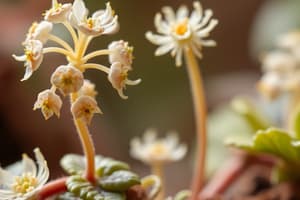Podcast
Questions and Answers
What is the primary difference between plant growth and development?
What is the primary difference between plant growth and development?
Plant growth refers to the increase in size, while development involves progression through various life stages.
Explain the role of mitotic cell division in plant growth.
Explain the role of mitotic cell division in plant growth.
Mitotic cell division initiates plant growth at the cellular level by creating new cells.
How do auxins influence plant growth?
How do auxins influence plant growth?
Auxins promote cell elongation and apical dominance and regulate phototropism and gravitropism.
What are the three main phases of plant development?
What are the three main phases of plant development?
Describe the function of gibberellins in plants.
Describe the function of gibberellins in plants.
What is photoperiodism, and how does it affect flowering in plants?
What is photoperiodism, and how does it affect flowering in plants?
Explain the importance of water in plant growth.
Explain the importance of water in plant growth.
What temperature conditions are necessary for optimal plant growth?
What temperature conditions are necessary for optimal plant growth?
What is thermoperiodism and how does it affect plant growth?
What is thermoperiodism and how does it affect plant growth?
List two macronutrients and two micronutrients essential for plant growth.
List two macronutrients and two micronutrients essential for plant growth.
Explain photoperiodism and its role in flowering.
Explain photoperiodism and its role in flowering.
What is vernalization, and which type of plant typically requires it?
What is vernalization, and which type of plant typically requires it?
What hormonal component is known to promote flowering in long-day and biennial plants?
What hormonal component is known to promote flowering in long-day and biennial plants?
Describe the process of floral maturation in the stages of flower development.
Describe the process of floral maturation in the stages of flower development.
What is leaf senescence, and why is it important for plants?
What is leaf senescence, and why is it important for plants?
What are two distinct types of senescence observed in plants?
What are two distinct types of senescence observed in plants?
Flashcards
Plant Growth
Plant Growth
The irreversible increase in size of a plant.
Plant Development
Plant Development
The progression through different life stages of a plant, like germination, flowering, and fruiting.
Cell Division
Cell Division
The process of cell division, where one cell splits into two.
Cell Elongation
Cell Elongation
Signup and view all the flashcards
Cell Differentiation
Cell Differentiation
Signup and view all the flashcards
Auxins
Auxins
Signup and view all the flashcards
Gibberellins
Gibberellins
Signup and view all the flashcards
Cytokinins
Cytokinins
Signup and view all the flashcards
Thermoperiodism
Thermoperiodism
Signup and view all the flashcards
Nutrients
Nutrients
Signup and view all the flashcards
Flowering
Flowering
Signup and view all the flashcards
Photoperiodism
Photoperiodism
Signup and view all the flashcards
Vernalization
Vernalization
Signup and view all the flashcards
Leaf Senescence
Leaf Senescence
Signup and view all the flashcards
Why is Flowering Important (Reproduction)
Why is Flowering Important (Reproduction)
Signup and view all the flashcards
Why is Flowering Important (Agriculture)
Why is Flowering Important (Agriculture)
Signup and view all the flashcards
Study Notes
Plant Growth and Development
- Plant growth is an irreversible increase in size, whereas development involves progressing through life stages like germination, vegetative growth, flowering, fruiting, and senescence.
Key Processes
- Cell Division: Growth begins at the cellular level through mitosis.
- Cell Elongation: After division, cells lengthen, contributing to overall plant size.
- Cell Differentiation: Cells become specialized into different tissues and organs (e.g., roots, stems, leaves).
Plant Growth Stages
- Sprout: Seed contains nutrients for germination and early leaf development.
- Seedling: Developing roots and spread require balanced nutrients.
- Vegetative: Nitrogen is important for stem and foliage growth.
- Budding: Plants need extra phosphorus during blooming.
- Flowering: Potassium is essential for healthy flowers and fruit.
- Ripening: Plants require water and no additional nutrients during final stage.
Growth Phases
- Embryonic: Starts after fertilization, during seed formation.
- Vegetative: Focuses on root and shoot system development.
- Reproductive: Flowering, pollination, and seed formation stages.
Hormonal Regulation of Growth
- Auxins: Promote cell elongation, apical dominance, phototropism, and gravitropism.
- Gibberellins: Stimulate stem elongation, seed germination, and flowering.
- Cytokinins: Promote cell division, delay leaf senescence, and encourage lateral bud growth, working against auxins.
- Ethylene: Involved in fruit ripening, leaf abscission, and stress responses.
- Abscisic Acid (ABA): Regulates stress responses, seed dormancy, and stomatal closure during drought.
Environmental Influences on Growth
- Light (Photoperiodism): Day length affects flowering (long-day vs. short-day plants). Photosynthesis converts light into chemical energy.
- Water: Crucial for turgor pressure, nutrient uptake, and transport.
- Temperature (Optimum Growth Range and Thermoperiodism): Optimal temperature ranges exist for growth and development, affected by daily temperature fluctuations.
- Nutrients: Macronutrients (e.g., Nitrogen, Phosphorus, Potassium) and micronutrients (e.g., Iron, Zinc) are essential for growth and development.
Flowering
- Flowering is the transition from vegetative growth to reproductive development, enabling seed production.
- Factors Influencing Flowering:
- Photoperiod: Plant response to day/night length (short vs. long-day plants).
- Vernalization: Cold temperatures may initiate flowering.
- Hormonal Control: Gibberellins can promote flowering in specific plants.
- Stages of Flower Development:
- Flower Induction: Triggers flower development based on external and internal cues.
- Floral Initiation: Reproductive meristem development into floral organs.
- Flower Maturation: Fully developed floral organs for pollination.
Importance of Flowering
- Reproduction: Flowers are the reproductive structures enabling seed production.
- Agriculture: Successful flowering is crucial for crop production.
- Pollinator Attraction: Flowers attract pollinators (e.g., bees, butterflies) for cross-pollination.
Leaf Senescence
- The natural aging process in leaves.
- Types: Whole plant, sequential, and stress-induced senescence.
- Visible: Yellowing due to chlorophyll breakdown.
- Molecular Aspects: Hormone regulation changes (e.g., decline in cytokinins, increase in ethylene and ABA).
- Importance:
- Nutrient Recycling: Redistributes nutrients.
- Stress Response: Defense mechanism under stress.
- Ecosystem Contributions: Organic matter decomposition.
- Controlled Cell Death: Prevents uncontrolled decay and facilitates nutrient recovery.
Studying That Suits You
Use AI to generate personalized quizzes and flashcards to suit your learning preferences.



